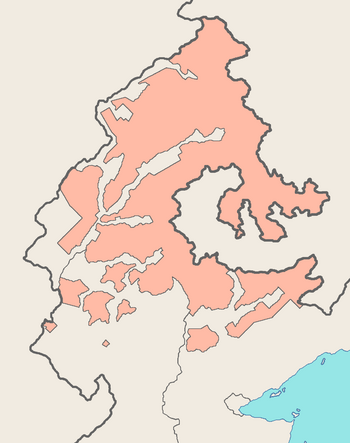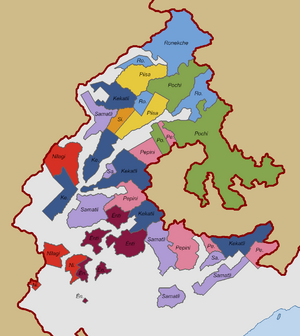Skarmic tribal hierarchy
Skarmic Tribal Hierarchy Cháçeetimiki | |
|---|---|
 Location of the Skarmic tribal hierarchy | |
| Common languages | Skarmic |
| Government | Hierarchical tribal federation |
• Hierarch | Kenah-Nonsa Kekatlimiket |
| Tilatl-Nonsa Samátlimiket | |
| Wepin-Ghá | |
| Wekep-Bos | |
| Legislature | Grand Council of the Nine Tribes |
| Area | |
• Total | 19,219 km2 (7,420 sq mi) |
| Population | |
• 2011 census | 635,903 |
• Density | 33.09/km2 (85.7/sq mi) |
The Skarmic tribal hierarchy (Skarmic: Cháçeetimiki) is a quasi-state and tribal federation with de jure status under the nation-state of Skarmia. The hierarchy operates as a form of monarchy, with the Nonsa of the Kekatli tribe usually taking the position of Hierarch (Skarmic: Bejaicháçeet). Legislatively, the hierarchy is governed by the Grand Council of the Nine Tribes, who administer the territories of the tribes as separate to the federal government, and can offer certain tax exemptions and levy its own taxes by the state.
The Skarmic tribal hierarchy has existed in various forms through history. It is believed that a less formalised version of the hierarchy existed prior to Beleroskov's rule over the Southwestern Krai, acting more as a confederation and potentially with no defined leader akin to the Hierarch of today. Certainly, with the rise of Beleroskovi influence in modern-day Skarmia, the Kekatli soon began to prove their loyalty to Beleroskov, finding them a strong position in both Beleroskovi and Skarmic society and placing them almost perpetually at the top of the hierarchy. By the time of the Zalsoker Autonomy, the hierarchy held sufficient power within the Krai to take de facto control of the region while the Beleroskovi government was indisposed fighting in the revolution. The Red March of Peace, led by Renalás-Ghá, a tribal leader within the Ronekche tribe, succeeded in preserving the tribal hierarchy through the socialist period, until the nation of Skarmia as it is known today emerged in 1999, with the tribal hierarchy intact.
While laws may technically differ among the member-tribes of the hierarchy, for the most part tribal law is applied all throughout the hierarchy's various lands, with each tribe and polk within deferring to the Grand Council. The tribes also have different internal political structures; the Kekatli operate as a hereditary monarchy, while the Ronekche have organised themselves more like a council of elders. With the tribal hierarchy being a core part of Skarmia, the terms "hierarchy", "tribe" and "polk" all have legal standing within the nation, and can be subject to vastly different customs and laws to those found in the rest of Skarmia.
Skarmic people make up 45.7% of the population of Skarmia, or just over 2.2 million, though the majority of these live in cities and towns around the nation rather than within the hierarchy lands. The Hierarchy Lands Commission, a sub-organisation of the Ministry of Culture and Tribal Affairs, has ten members of the Grand Council of the Nine Tribes on its administrative committee, and oversees the federal government's interactions with the hierarchy's land holdings. The total land area of the tribal hierarchy is 19,219km2 (7,420sqmi), 36.92% of Skarmia's total land area, most of which is rural and regional highland.
Terminology
In English, the official name for the area is "Skarmic tribal hierarchy". This is a translation of the Beleroskovi Skarmicheskaya plemennaya iyerarkhiya, the official state-sanctioned Beleroskovi-language term for the lands of the hierarchy since their formalisation in 1577. Notably, the name for the region may be capitalised, but formally it remains uncapitalised. Numerous attempts to change the Beleroskovi name for the region have been discussed, but ultimately rejected. These included names such as Skarmicheskiye natsii ("Skarmic nations"), Devyat' natsiy ("Nine nations"), Krasnaya zemlya ("Red land") amongst others.
In Skarmic, the region is generally referred to as Cháçeetimiki, though in an official capacity, the region may also be known as Cháçeetimikiet ieskarmitzin.
History
Skarmic tribal hierarchy and government jurisdiction
Given the tribal hierarchy's predating of the nation of Skarmia, the relationship between the powers of both hierarchy and federation is complicated and backed by numerous laws, treaties and constitutional amendment.
The Southwestern Krai asserted plenary power over the hierarchy throughout its existence, requiring that all laws submitted by the hierarchy's leadership must be passed through the Krai's government for secretarial review and approval. In general, few true disagreements or rejections of hierarchy law ever emerged during the Krai's existence, with the Krai's policy being largely to leave the hierarchy be and to govern the lands of the Krai proper. Disagreements did occur, however, when it came to land purchases by the government of the Krai itself. For the development of true cities and larger towns, the Krai refused to share power, and so would often force them to sell the land at reduced prices by continually rejecting proposed laws until the hierarchy relented.
During the period of the Socialist Republic, the interactions between hierarchy and government changed a number of times. Renalás-Ghá's policy attempted to integrate the hierarchy's structures into those of the Socialist Republic, briefly creating a unified assembly that combined elements of both the Grand Council of the Nine Tribes and the various workers' councils of Skarmia. This option proved unpopular for both groups - the hierarchy asserted that it attempted to negate their influence, while the workers' councils accused the hierarchy of revisionism, and so the result of Renalás-Ghá's administration was largely a return to the status quo. After the 1929 Skarmian coup d'état and the removal of Qakinik-Wa from power, an attempt was made by the Beleroskovi members of the councils to revoke the status of the hierarchy within the Socialist Republic, though as the councils had a plurality of Skarmic members, this was blocked. Instead, the Socialist government enforced national powers over the hierarchy, reducing the power of the Hierarch and restricting the scope of the laws it was possible for the hierarchy to pass. This culminated in the formal classification of hierarchy lands into "core regions" (where the hierarchy had increased control and purview), "outlying areas" (where the hierarchy oversaw various government-approved programs but did not have any legislative power of its own) and "associated lands" (lands culturally connected to the hierarchy but legislatively parts of the state). This system has continued into the modern day, though the core regions have been largely expanded and the outlying areas have been all but absorbed into the other two categories.
Into the modern day, interactions between the hierarchy and the government are overseen by the Ministry of Culture and Tribal Affairs.
Government
The government of the hierarchy is two-part, with the executive and legislative being under the purview of the Grand Council of the Nine Tribes and its Hierarch, and judiciary power being under the purview of the High Court.
Grand Council of the Nine Tribes
Operating as both the legislative and executive branches of government, the Grand Council of the Nine Tribes is an unequal representative council, being an assembly of 171 gháumi. Typically, gháumi are selected from different polki within a tribe, and each tribe may select a predefined number of the gháumi within their tribe to send to the Grand Council. Usually, gháumi are also the leaders of their polki, though this is not typically a rule. The seats within the Grand Council are distributed among the Nine Tribes as follows:
Hierarch
The Hierarch of the Skarmic Tribes has consistently also been the Nonsa of the Kekatli since the formalisation of the role in 1732. The Hierarch serves as joint head of state and head of government, and given the hereditary nature of the Kekatli Nonsimik, it has been de facto a hereditary title for that time.
Right Hand to the Hierarch
The Right Hand to the Hierarch has consistently also been the Nonsa of the Samatli since the formalisation of that role in 1846. The Right Hand to the Hierarch serves as the protector of the Hierarchy militarily, the secretary of state and a key part of the foreign ministry.
Speaker of the Grand Council
The Speaker of the Grand Council is the official elected by the legislature to chair meetings for a period of two and a quarter years (or nine seasons), renewable after nine years.
Judiciary
Administrative divisions
Tribes
Hierarchy lands
Polki
Geography
The land area of the Skarmic tribal hierarchy, including all hierarchy lands, is 19,219 km2 (7,420sqmi), 36.92% of Skarmia's total land area. Having land in every Oblasc-level subdivision except for Zalsoker-Gorda, the lands of the hierarchy are larger than any individual Oblasc. Each hierarchy land is derived from a parcel of land sold or gifted to, or otherwise recognised as a part of, the hierarchy for its own use. There are numerous exclaves of the hierarchy's lands, though given the contiguous nature of the Skarmian road network, and the (historical) requirement that the hierarchy's lands exclude major roads, there are no enclaves within the hierarchy's lands.
The hierarchy's territory covers the majority of the highland region of Skarmia, with most of the country's highest peaks lying within one or more of the tribes there. Each of the land parcels has a distinct name, and contains a number of polki within its borders. The vast majority of the land, over 95%, is owned by native Skarmic people through the hierarchy's own land use infrastructure, though the remaining land is owned by non-natives through the provisions of the Hierarchy Lands Commission.

